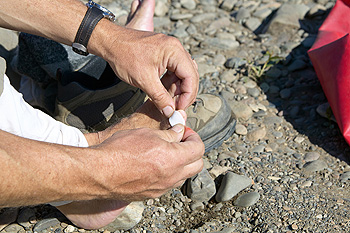
A bunion is a bony bump that forms at the base of the big toe when the joint becomes misaligned as the toe leans inward. This deformity often results from prolonged pressure on the foot, commonly due to wearing tight or ill-fitting shoes. Other causes include inherited foot structure, arthritis, or uneven weight distribution. Symptoms of a bunion include pain, swelling, redness, and restricted movement of the toe. Over time, the bump may become more prominent and uncomfortable, especially during walking or while wearing shoes. Risk factors include a family history of bunions, flat feet, and occupations or activities that place stress on the feet. Bunions may be uncomfortable, and it may become difficult completing daily activities. If this applies to you, it is suggested that you consult a podiatrist who can offer effective relief and treatment solutions.
If you are suffering from bunions, contact Mohammad R. Parsa, DPM of Madison Foot Clinic. our doctor can provide the care you need to keep you pain-free and on your feet.
What Is a Bunion?
A bunion is formed of swollen tissue or an enlargement of boney growth, usually located at the base joint of the toe that connects to the foot. The swelling occurs due to the bones in the big toe shifting inward, which impacts the other toes of the foot. This causes the area around the base of the big toe to become inflamed and painful.
Why Do Bunions Form?
Genetics – Susceptibility to bunions are often hereditary
Stress on the feet – Poorly fitted and uncomfortable footwear that places stress on feet, such as heels, can worsen existing bunions
How Are Bunions Diagnosed?
Doctors often perform two tests – blood tests and x-rays – when trying to diagnose bunions, especially in the early stages of development. Blood tests help determine if the foot pain is being caused by something else, such as arthritis, while x-rays provide a clear picture of your bone structure to your doctor.
How Are Bunions Treated?
- Refrain from wearing heels or similar shoes that cause discomfort
- Select wider shoes that can provide more comfort and reduce pain
- Anti-inflammatory and pain management drugs
- Orthotics or foot inserts
- Surgery
If you have any questions, please feel free to contact our office located in Madison, MS . We offer the newest diagnostic and treatment technologies for all your foot care needs.

A calcaneal spur, often called a heel spur, is a bony growth that can quietly develop on the underside of the heel bone. While it may go unnoticed at first, it can lead to persistent or stabbing pain, especially with the first steps in the morning or after sitting for long periods. This condition is frequently associated with strain on the plantar fascia and is more common in individuals who spend long hours standing, have abnormal foot mechanics, or wear unsupportive shoes. The pain may worsen over time, eventually interfering with your ability to walk comfortably or maintain regular activity. In some cases, the discomfort leads to changes in posture or gait that cause further strain on other joints. Early attention can help prevent progression and reduce long-term impact. If you are experiencing ongoing heel pain, it is suggested that you see a podiatrist for a proper diagnosis and appropriate treatment.
Heel spurs can be incredibly painful and sometimes may make you unable to participate in physical activities. To get medical care for your heel spurs, contact Mohammad R. Parsa, DPM from Madison Foot Clinic. our doctor will do everything possible to treat your condition.
Heels Spurs
Heel spurs are formed by calcium deposits on the back of the foot where the heel is. This can also be caused by small fragments of bone breaking off one section of the foot, attaching onto the back of the foot. Heel spurs can also be bone growth on the back of the foot and may grow in the direction of the arch of the foot.
Older individuals usually suffer from heel spurs and pain sometimes intensifies with age. One of the main condition's spurs are related to is plantar fasciitis.
Pain
The pain associated with spurs is often because of weight placed on the feet. When someone is walking, their entire weight is concentrated on the feet. Bone spurs then have the tendency to affect other bones and tissues around the foot. As the pain continues, the feet will become tender and sensitive over time.
Treatments
There are many ways to treat heel spurs. If one is suffering from heel spurs in conjunction with pain, there are several methods for healing. Medication, surgery, and herbal care are some options.
If you have any questions feel free to contact our office located in Madison, MS . We offer the latest in diagnostic and treatment technology to meet your needs.

Blisters are a frequent issue for hikers and can make even the most enjoyable trek uncomfortable. They form when repeated pressure and friction cause the skin layers to separate, allowing fluid to accumulate as a protective response. Direct friction from ill-fitting boots or socks rubbing against the skin increases the risk of blister formation. Moisture from sweat or wet conditions softens the skin, making it more prone to irritation and damage. Extended hiking over rough or uneven terrain can further intensify these effects. Foot blisters can be painful, causing hiking to become difficult. If you have developed a blister while hiking, it is suggested that you visit a podiatrist who can offer you relief and preventative methods.
Blisters are prone to making everyday activities extremely uncomfortable. If your feet are hurting, contact Mohammad R. Parsa, DPM of Madison Foot Clinic. our doctor can provide the care you need to keep you pain-free and on your feet.
Foot Blisters
Foot blisters develop as a result of constantly wearing tight or ill-fitting footwear. This happens due to the constant rubbing from the shoe, which can often lead to pain.
What Are Foot Blisters?
A foot blister is a small fluid-filled pocket that forms on the upper-most layer of the skin. Blisters are filled with clear fluid and can lead to blood drainage or pus if the area becomes infected.
How Do Blisters Form?
Blisters on the feet are often the result of constant friction of skin and material, usually by shoe rubbing. Walking in sandals, boots, or shoes that don’t fit properly for long periods of time can result in a blister. Having consistent foot moisture and humidity can easily lead to blister formation.
Prevention & Treatment
It is important to properly care for the affected area in order to prevent infection and ease the pain. Do not lance the blister and use a Band-Aid to provide pain relief. Also, be sure to keep your feet dry and wear proper fitting shoes. If you see blood or pus in a blister, seek assistance from a podiatrist.
If you have any questions, please feel free to contact our office located in Madison, MS . We offer the newest diagnostic and treatment technologies for all your foot care needs.

Walking aids can help patients with foot, toe, or ankle conditions by improving stability and decreasing the risk of falling. Canes, including single-point and quad canes, provide support for those with mild to moderate balance issues or weakness. Crutches are useful for keeping weight off an injured foot or ankle, but require upper body strength. Walkers offer greater support and are beneficial for patients with significant balance concerns. Rollators, which have wheels and hand brakes, allow for easier movement while preventing a sudden loss of balance. Additionally, knee walkers help patients recovering from ankle injuries or surgery by enabling mobility without placing weight on the affected limb. Choosing the wrong walking aid, or using one that is not properly adjusted, can add to instability. A podiatrist can assess your foot and ankle condition, determine whether a walking aid is needed, and recommend the most appropriate option to improve stability and prevent falling. If you need a walking aid to help with balance issues, it is suggested that you schedule an appointment with a podiatrist for advice.
Preventing falls among the elderly is very important. If you are older and have fallen or fear that you are prone to falling, consult with Mohammad R. Parsa, DPM from Madison Foot Clinic. our doctor will assess your condition and provide you with quality advice and care.
Every 11 seconds, an elderly American is being treated in an emergency room for a fall related injury. Falls are the leading cause of head and hip injuries for those 65 and older. Due to decreases in strength, balance, senses, and lack of awareness, elderly persons are very susceptible to falling. Thankfully, there are a number of things older persons can do to prevent falls.
How to Prevent Falls
Some effective methods that older persons can do to prevent falls include:
- Enrolling in strength and balance exercise program to increase balance and strength
- Periodically having your sight and hearing checked
- Discuss any medications you have with a doctor to see if it increases the risk of falling
- Clearing the house of falling hazards and installing devices like grab bars and railings
- Utilizing a walker or cane
- Wearing shoes that provide good support and cushioning
- Talking to family members about falling and increasing awareness
Falling can be a traumatic and embarrassing experience for elderly persons; this can make them less willing to leave the house, and less willing to talk to someone about their fears of falling. Doing such things, however, will increase the likelihood of tripping or losing one’s balance. Knowing the causes of falling and how to prevent them is the best way to mitigate the risk of serious injury.
If you have any questions, please feel free to contact our office located in Madison, MS . We offer the newest diagnostic and treatment technologies for all your foot care needs.
